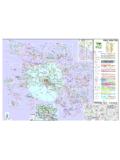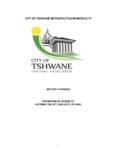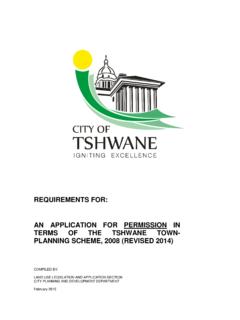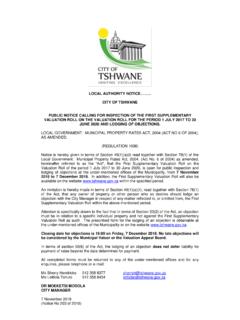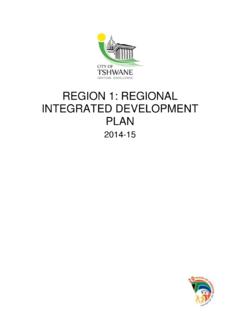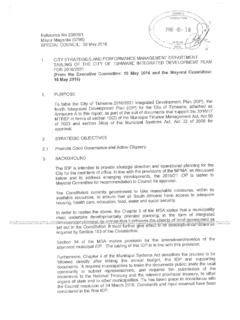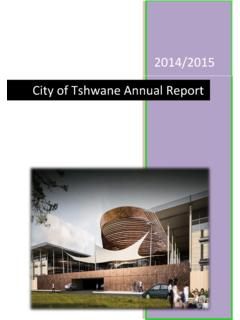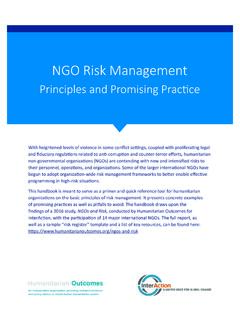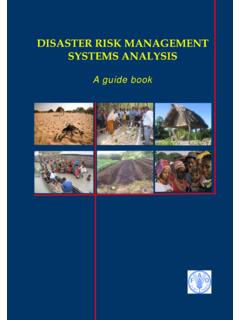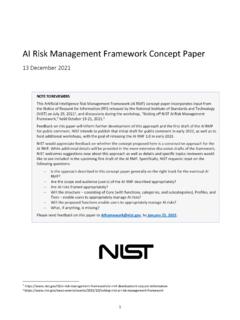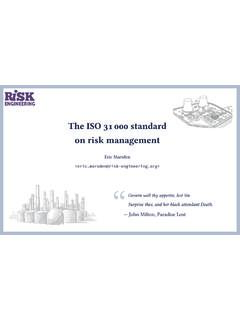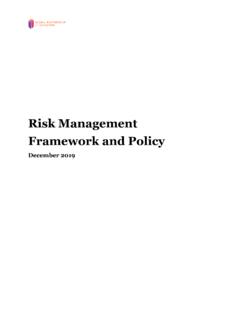Transcription of Disaster Management Plan
1 CITY OF TSHWANE Disaster Management Plan Updated Level 1 Disaster Management Centre 2011 | Updated by | Disaster Management Officers | OC Tshitannye | KZ Khotlele | KJ Matebane | TJ Tshifaro | SV Mnguni | ACCRONYMS CBO Community based organisation CoT City of Tshwane CoT DRMF City of Tshwane Disaster Risk Management Framework DMA Disaster Management Act No. 57 of 2002. DMIS Disaster Management Information System DOC Disaster Operations Centre DRA Disaster Risk Assessment DRR Disaster Risk Reduction DRMAF Disaster Risk Management Advisory Forum DRMP Disaster Risk Management Plan EIA Environmental Impact Assessment FOG Field Operations Guide FPA Fire Protection Association GIS
2 Geographical Information Systems GM General Manager GP PDMC Gauteng Province Provincial Disaster Management Centre GPDMF Gauteng Province Provincial Disaster Management Framework GPS Geographical Positioning System IDP Integrated Development Plan IRCS International Red Cross Society JOC Joint Operations Centre KPA Key Performance Area MDG Millennium Development Goals MDMC Municipal Disaster Management Centre MFMA Municipal Financial Management Act No.
3 56 of 2003 MMC Member of the Mayoral Committee NDMC National Disaster Management Centre NDMF National Disaster Management Framework NGO Non- governmental organisation PDMC Provincial Disaster Management Centre PDMF Provincial Disaster Risk Management Framework PFMA Public Financial Management Act No. 1 of 1999 SED Strategic Executive Director SOP Standard Operating Procedure VOC Venue Operations Centre DEFINITIONS Disaster is a progressive or sudden widespread or localized, natural or human-caused occurrence which causes or threatens to cause death or injury, damage to property, infrastructure or environment, disruption of life of a community and its magnitude exceeds the ability of those affected to cope using only their own resources.
4 Disaster Management is a continuous and integrated multisectoral and multidisciplinary process of planning and implementation of measures aimed at Disaster prevention, mitigation, preparedness, response, recovery and rehabilitation. Risk is a probability of a hazard occurring or threatening to occur Prevention means activities to provide outright avoidance of the adverse impact of hazards and means to minimize related environmental, technological and biological disasters. Mitigation means structural and non-structural measures undertaken to limit the adverse impact of natural hazards, environmental degradation and technological hazards. Preparedness means activities and measures taken in advance to ensure effective response to the impact of hazards, including the issuance of timely and effective early warnings and the temporary evacuation of people and property from threatened locations.
5 Response means measures taken during or immediately after an incident or a Disaster in order to bring relief to affected communities or individuals Recovery means efforts, including development aimed at creating a situation where- (a) Normality in conditions caused by a Disaster is restored; (b) The effects of a Disaster are mitigated; or (c) Circumstances are created that will reduce the risk of a similar Disaster occurring Capacity is a combination of all the strengths and resources available within a community, society or organization that can reduce the level of risk, or the effects of a Disaster . Hazard is a potentially damaging physical event, phenomenon or human activity that may cause the loss of life or injury, property damage, social and economic disruption or environmental degradation.
6 Disaster risk reduction is the conceptual framework of elements considered with the possibilities to minimize vulnerabilities and Disaster risks throughout a society, to avoid (prevention) or to limit (mitigation and preparedness) the adverse impacts of hazards, within the broad context of sustainable development. Environmental Impact Assessments are studies undertaken in order to assess the effect on a specified environment of the introduction of any new factor, which may upset the current ecological balance. Environmental degradation is the reduction of the capacity of the environment to meet social and ecological objectives, and needs. Geographic Information System is an analysis that combines relational databases with spatial interpretation and outputs often in form of maps.
7 A more elaborate definition is that of computer programmes for capturing, storing, checking, integrating, analysing and displaying data about the earth that is spatially referenced. CONTENTS Executive Summary .. 8 1. Custodian Of The Plan .. 10 3. Legislative Mandate .. 12 4. Purpose .. 12 5. City Of Tshwane Overview .. 13 6. Disaster Management Planning Overview .. 14 Foundational Institutional Arrangements .. 15 Disaster Risk Management Policy Framework .. 16 Emergency Services Department Top Management Committee .. 18 Disaster Risk Management Advisory Forum .. 19 Ngo Forum .. 22 Other Sub-Fora .. 25 Municipal Disaster Management Centre (Mdmc) .. 27 Sub-Structures Of The Mdmc.
8 32 Divisional Disaster Risk Management Focal Points .. 33 7. The Disaster Risk Management Planning Framework ..60 Risk Reduction Planning .. 60 Contingency Planning .. 61 8. Disaster Risk Assessment For The Cot .. 65 Macro Vulnerability Assessment .. 70 9. The Disaster Risk Profile Of The Cot .. 77 10. Formal Consultative Mechanism For DRR Projects .. 78 IDP Projects Contributing To Vulnerability And Hazard Reduction .. 79 11. Disaster Risk Management Planning Priorities For The Cot .. 79 12. Incentive System For The Promotion Of DRM In The Cot .. 81 13. Disaster Risk Management Information System .. 82 14. Emergency Communication System .. 83 15. Areas For Focussed Disaster Risk Assessments.
9 86 16. Implementation Strategy For The DRM Plan .. 86 EXECUTIVE SUMMARY Disaster risk Management has become the major challenge the entire world is faced with currently owing to the ever growing population, climate change, and the ever changing environment in general. Natural and man-made disasters result in economic as well as environmental losses which places a need for systematic approach to Management of risks . The Constitution of the Republic of South Africa (Act 108 of 1996) places a legal obligation on the Government of South Africa to ensure the health (personal and environment) and safety of its citizens. In terms of section 41(1)(b) of the Constitution, all spheres of Government are required to secure the well-being of the people of the Republic.
10 Section 152(1)(d) also requires that local government ensure a safe and healthy environment . In the light of the above, and the established understanding of Disaster Management , the primary responsibility for Disaster risk Management in South Africa rests with Government. Section 26(g) of the Municipal Systems Act 32 of 2000 as well as sections 52 and 53 of the Disaster Management Act 57 of 2002 compels each municipal entity to develop a Disaster risk Management plan as part of and an integrated part of their Integrated Development Plans. This plan establishes the arrangements for Disaster risk Management within the City of Tshwane (CoT) and has been prepared in accordance with the requirements of the Disaster Management Act, 57 of 2002 (the Act) and section 26(g) of the Municipal Systems Act, 2000.
